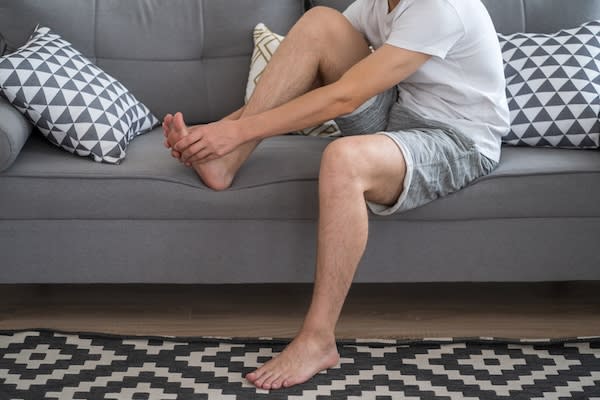Bone spurs: Why they may not be an issue

[5 MIN READ]
In this article:
-
Bone spurs don’t usually cause symptoms or problems themselves; rather, they are an indicator that you have an injury.
-
The best treatment for a condition that caused a bone spur is physical therapy.
-
If you want to avoid bone spurs, keep a close eye on your nutrition and weight, and develop a regular exercise routine.
Bone spurs: Causes, symptoms and treatment
If you’ve ever heard someone complain that their bone spur is feeling particularly achy today, you have a golden opportunity to sound really smart.
“Bone spurs don’t really cause symptoms on their own,” says Neel Raval, M.D., a Providence sports medicine specialist who sees patients in Los Angeles, California. “Any symptoms that you experience are the result of the underlying condition that has led to the bone spur, like Achilles tendinopathy, for example.”
So, what exactly are bone spurs, and what do you do about them? Here, Dr. Raval explains.
What are bone spurs?
Bone spurs, also called enthesophytes, are extra growths of bone tissue that form where tendons insert into the bone. They look like smooth lumps on the outsides of your bones.
“Bone spurs form wherever you have a long tendon that is inserting itself onto the bone,” says Dr. Raval. “The reason the new bone forms is because of a chronic shortening of that tendon. It’s undergoing remodeling and shaping.”
That tissue damage is most often the result of chronic tendinopathy or an injury, such as various types of tendinitis. Other causes of bone spurs include:
- Lupus
- Degenerative disk disease
- Spinal stenosis
- Repetitive strain injuries
- Accidents or sports injuries
Symptoms of bone spurs
As noted above, bone spurs typically don’t cause symptoms, but the underlying cause can lead to pain, stiffness or difficulty with range of motion when certain bones move. Additionally, if the bone spur is putting pressure on a nerve, it can cause tingling, numbness or pain.
You may not know you have a bone spur unless you have an imaging test for another condition that happens to reveal it.
Treatment options
According to Dr. Raval, there is no specific bone spur treatment. Rather, you need to treat the underlying issue — and the best way to do that is through physical therapy and pain management.
“The important thing is an eccentric strengthening of muscles,” he says. “Normally, when you do an exercise, it’s a concentric movement — a shortening of the muscles while providing force against resistance. Eccentric is the opposite, where you’re focusing on slowing down the lengthening phase of the exercise, a type of muscle contraction in which the muscle lengthens under tension.”
As you strengthen the muscle, Dr. Raval says, the pain will gradually decrease and the muscle will heal. However, he cautions, the bone spur will remain.
“Once a bone spur has developed, it won’t go away,” he says. “It’s a conversation I often have with patients who ask if they can get the bone spur removed to get rid of their symptoms. I like to show them the X-rays — the bone spur is simply an indicator that there is or was something going on. Twenty years from now, an X-ray will still show that extra bone.”
That said, in uncommon cases, bone spurs can cause problems. If a bone spur has grown very large and is causing major issues, your doctor might suggest surgery to remove it — but that doesn’t happen very often. “Surgery is an extremely rare treatment for bone spurs,” says Dr. Raval.
Preventing bone spurs
One of the keys to preventing many kinds of bone spurs, says Dr. Raval, is to focus on eccentric strengthening in addition to concentric strengthening. “Perform a dynamic warm-up before exercising, and include static stretching as a cool-down,” he says.
In some cases, however, bone spurs are simply a natural result of aging and age-related tissue degeneration. But there are some steps you can take to slow the process of tissue degeneration, including:
- Exercising – As Dr. Raval points out, any exercise routine should include plenty of stretching.
- Losing weight – Extra weight can contribute to the formation of bone spurs.
- Practicing good posture – This can prevent repetitive stress injuries.
In many cases, bone spurs may not cause you any trouble. But if they do, your Providence orthopedic surgeon or sports medicine provider can help you find a solution.
Contributing caregiver
Neel Raval, M.D., is a Providence sports medicine specialist who sees patients in Los Angeles, California.
Find a doctor
If you are looking for a sports medicine specialist, you can find what you are looking for in our provider directory. Through Providence Express Care Virtual, you can access a full range of health care services.
Download the Providence app
It’s all in the app: easily stay connected with Providence and your health. With the Providence app, you can schedule appointments, have virtual visits from the comfort of your home, get personalized health recommendations, access your health records and so much more. Learn more and download the app.
Related resources
Get moving: Exercises for older adults
How you can stay at home as you age
This information is not intended as a substitute for professional medical care. Always follow your health care professional’s instructions.